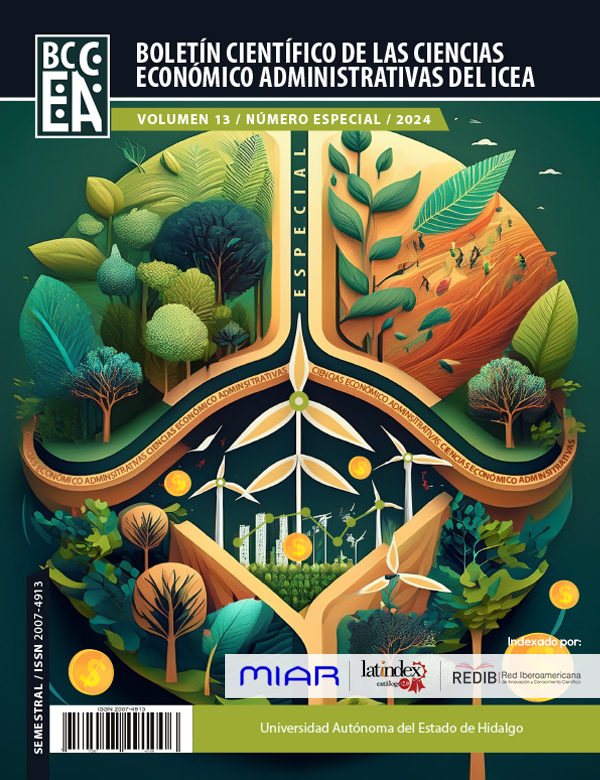Income as a determinant in tobacco expenditure. Analysis 2020-2022
Abstract
This study analyzed the relationship of tobacco expenditure with health expenditure and the average income of Mexican households. Using data from the ENIGH 2020 and 2022. A multiple linear regression model was constructed with the purpose of linking the described variables and generating information that contributes to the design of public policies to reduce the effects of tobacco on people. It was found that the health-tobacco elasticity is inelastic and the income-tobacco elasticity is elastic. A difference in tobacco consumption was observed between households of different incomes, indicating that lowering income more than proportionally reduces spending on tobacco. This suggests that fiscal policies are efficient in reducing tobacco consumption.
Downloads
References
U.S. National Cancer Institute, & World Health Organization. (2016). The Economics of Tobacco and Tobacco Control. National Cancer Institute Tobacco Control Monograph 21. NIH Publication No. 16-CA-8029A. https://cancercontrol.cancer.gov/sites/default/files/2020-06/m21_complete.pdf
Instituto Nacional de Estadística y Geografía. (2020). Encuesta Nacional de Ingresos y Gastos de los Hogares (ENIGH). 2020 Nueva serie. https://www.inegi.org.mx/programas/enigh/nc/2020/
Rebollar, S., Guzmán, E., Terrones, A., Gonzáles, F., & Hernández, J. (2022). Microeconomía básica (1.a ed.). Buk (Readonline, S. A. de C. V.). https://mail.google.com/mail/u/1/#search/micro/FMfcgzGrcPDrbQXPXpvRlZKlkdrPsrJF?projector=1&messagePartId=0.1
Meneses, K., Cisneros, M., & Braganza, M. (2019). Análisis socioeconómico del consumo excesivo de alcohol en Ecuador. Revista ciencias de la salud. Universidad del Rosario, 17(2), 293–308. https://doi.org/10.12804/revistas.urosario.edu.co/revsalud/a.7938
Mankiw, N., 2012. Principios de Economía. Sexta ed. México: Cengage Learning.
Vázquez-Segovia, L. A., Sesma-Vázquez, S., & Hernández-Ávila, M. (2002). El consumo de tabaco en los hogares en México: resultados de la Encuesta de Ingresos y Gastos de los Hogares,1984-2000. Salud Pública De México, 44, s76-s81. https://doi.org/10.1590/s0036-36342002000700012
Huesca, L., Llamas, L., Vargas Téllez, C. O., & De la Ree J. L, (2023). Impuestos al tabaco en México y federalismo fiscal Tobacconomics Working Paper Series. https://doi.org/10.1186/s12939-021.01603.2
Fernández, E., Schiaffino, A., & Peris, M. (2001). Tabaquismo en mujeres: un problema de salud emergente. Enfermedades emergentes. Departamento de Salud Pública. Universidad de Barcelona, 184-190. http://enfermedadesemergentes.com/articulos/a99/s-3-4-004.pdf
Organización Mundial de la Salud. (2022). Informe OMS sobre la epidemia mundial de tabaquismo, 2021: abordar los productos nuevos y emergentes. https://iris.who.int/bitstream/handle/10665/363178/9789240055490-spa.pdf?sequence=1&isAllowed=y
Instituto Nacional de Estadística y Geografía. (2022). Encuesta Nacional de Ingresos y Gastos de los Hogares (ENIGH). 2022 Nueva serie. https://www.inegi.org.mx/programas/enigh/nc/2022/
De La Rosa, L., & Otero, M. (2004, 1 abril). Tabaquismo en la mujer: consideraciones especiales. Unidad de Tabaquismo. Facultad de Medicina. Universidad de Cantabria. Santander. España., Vol. 6 Núm. 2, 113-124
Benowitz, N. L. (1988). Pharmacologic aspects of cigarette smoking and nicotine addiction. The New England Journal of Medicine, 319(20), 1318-1330. https://doi.org/10.1056/nejm198811173192005
Becoña, E. y Vázquez, F. L., (2000). Las mujeres y el tabaco: características ligadas al género. Revista Española de Salud Pública 74(1). doi: 10.1590/s1135-57272000000100003
Comisión Nacional contra las Adicciones & Secretaría de Salud. (2017). TABAQUISMO EN BAJA CALIFORNIA SUR. Gobierno de México. https://www.gob.mx/cms/uploads/attachment/file/547216/Baja_California_Sur_Infografia_Tabaquismo-CONADIC.pdf
Becker, G. S., Grossman, M., & Murphy, K. M. (1994). An Empirical Analysis of Cigarette Addiction. The American Economic Review, 84(3), 396–418. http://www.jstor.org/stable/2118059
Becoña, E. (2003). Tabaco, ansiedad y estrés. Salud y Drogas, 3(1), 71-92. https://www.redalyc.org/pdf/839/83930106.pdf
Gujarati, D. y Porter, D. (2010) Econometría. The McGraw-Hill Companies, Inc. Disponible en: https://drive.google.com/drive/u/1/search?q=gujarati.
Shrestha, S. S., Davis, K., Mann, N., Taylor, N., Nonnemaker, J., Murphy-Hoefer, R., Trivers, K. F., King, B. A., Babb, S., & Armour, B. S. (2021). Cost Effectiveness of the Tips From Former Smokers® Campaign—U.S., 2012–2018. American Journal Of Preventive Medicine, 60(3), 406-410. https://doi.org/10.1016/j.amepre.2020.10.009
Secretaría de Gobernación. (2022). Diario Oficial de la Federación. https://dof.gob.mx/nota_detalle.php?codigo=5675897&fecha=28/12/2022#gsc.tab=0
Instituto Nacional de Estadística y Geografía. (2023). Consulta de Precios Promedio. https://www.inegi.org.mx/app/preciospromedio/?bs=18
Copyright (c) 2024 Javier Arturo Rosales Sánchez, Eduardo Rodríguez Juárez

This work is licensed under a Creative Commons Attribution-NonCommercial-NoDerivatives 4.0 International License.











